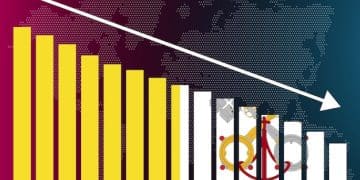College Tuition Hikes: Long-Term Impact on Students and Families

The continuous escalation of college tuition costs in the United States significantly impacts students and families by deepening debt burdens, limiting educational access, and shaping future economic stability, necessitating a reevaluation of funding and affordability models.
The rising cost of college tuition has become a topic of increasing concern across the United States. For many prospective students and their families, the dream of higher education is now shadowed by the daunting financial implications. Understanding the long-term effects of this upward trend is crucial, as it fundamentally reshapes individual financial landscapes and broader societal structures.
The Escalating Tuition Trend: A Historical Perspective
Understanding the current predicament of college affordability requires a look back at how tuition costs have evolved over decades. What began as a relatively manageable expense for many families has transformed into a substantial financial hurdle. This section explores the historical trajectory of tuition increases and the key factors contributing to this persistent upward trend, setting the stage for a deeper analysis of its implications.
A Rapid Ascent in Costs
For more than four decades, college tuition has consistently outpaced general inflation and wage growth. This relentless rise means that a degree that was once within reach for many middle-class families now demands significant financial sacrifices, often requiring substantial borrowing. The sticker price of attending a four-year institution, whether public or private, has soared, leading to widespread concern among policymakers and the public.
- Decreased State Funding: Many states have reduced their financial contributions to public higher education, shifting more of the cost burden onto students.
- Increased Demand: The growing societal emphasis on obtaining a college degree has led to increased demand, allowing institutions to raise prices.
- Administrative Bloat: Universities have seen an expansion in administrative staff and amenities, contributing to overhead costs passed on to students.
- Limited Competition: The perceived prestige of certain institutions can limit price competition, enabling them to command higher tuition fees.
The confluence of these factors has created an environment where colleges, particularly those with strong reputations, can continue to increase their prices without a corresponding decrease in demand. This dynamic, coupled with the essential role a college degree now plays in many career paths, leaves families with few viable alternatives to absorbing these escalating costs.
This historical pattern of increasing tuition has significant consequences, laying the groundwork for the financial challenges students and families face today. The implications range from changes in enrollment patterns to the burgeoning student loan crisis, each facet being a direct result of this sustained upward climb in educational expenses. A deeper dive into these effects is critical for grasping the full scope of the issue.
The Burden of Student Loan Debt: A Ripple Effect
One of the most immediate and tangible consequences of rising tuition is the explosion of student loan debt. This debt is not merely a financial statistic; it represents a profound weight on millions of individuals, affecting their life choices, economic mobility, and psychological well-being. Examining the scale and impact of this debt reveals a complex web of challenges facing a generation.
The average student loan debt continues to climb, with many graduates owing tens of thousands of dollars. For some, this figure can reach six figures, particularly for those pursuing advanced degrees or attending costly private institutions. This debt often begins accruing interest even before graduation, making it a persistent companion long after students receive their diplomas.
Impact on Major Life Milestones
The burden of student loan debt extends far beyond monthly payments. It significantly delays or even prevents young adults from achieving traditional markers of adulthood and financial stability. From purchasing a home to starting a family, these aspirations often take a back seat to the relentless demand of loan repayment. This delay has broader economic implications, as it can slow down consumer spending and investment.
The daily reality for many graduates is a careful balancing act between managing their existing debt and attempting to save for future goals. This financial tightrope walk can lead to significant stress and anxiety, impacting overall quality of life. The psychological toll of living with substantial debt should not be underestimated, as it can affect mental health and relationship stability.
- Delayed Homeownership: High debt-to-income ratios make it difficult to qualify for mortgages, pushing homeownership further out of reach.
- Postponed Marriage and Family: Financial instability can lead individuals to delay marriage or having children, affecting societal demographic trends.
- Lower Entrepreneurship Rates: The risk aversion associated with debt can deter graduates from pursuing entrepreneurial ventures, limiting innovation.
- Reduced Retirement Savings: Prioritizing loan payments often means less money allocated to long-term savings, impacting future financial security.
Furthermore, student loan debt disproportionately affects certain demographic groups, exacerbating existing economic inequalities. Minority students, often with less generational wealth, typically borrow more and struggle more to repay their loans. This creates a cycle where educational debt perpetuates economic disparities across communities and generations.
The ripple effect of student loan debt is thus pervasive, touching individual lives, household economies, and the broader macroeconomy. Addressing the root causes of rising tuition is paramount to mitigating this crisis and safeguarding the financial futures of upcoming generations.
Access and Equity: Who Gets to Go to College?
As tuition costs surge, concerns about equitable access to higher education naturally intensify. The narrative that college is a pathway to upward mobility becomes increasingly complex when financial barriers disproportionately affect certain segments of the population. This section delves into how rising costs influence who can and cannot pursue a college degree, highlighting the implications for social mobility and workforce diversity.
For low-income and first-generation students, the financial hurdle of college can be insurmountable, even with financial aid. While scholarships and grants exist, they often do not fully cover the “unmet need”—the gap between the cost of attendance and a family’s ability to pay, even after aid. This forces many students to either take on significant debt or forgo higher education altogether, irrespective of their academic potential. The sheer sticker price alone can be a deterrent, causing students from less affluent backgrounds to self-select out of applying to more expensive, though often highly ranked, institutions.
Widening the Opportunity Gap
The disparity in educational attainment based on socioeconomic status continues to grow, fueled by escalating college costs. Students from affluent backgrounds are more likely to attend and graduate from four-year institutions, particularly those with higher prestige. This creates a feedback loop where privilege begets more privilege, and the pathways to economic advancement narrow for those already facing disadvantages.
Moreover, the choice of major or career path can also be influenced by the need to repay loans. Students might gravitate towards fields perceived as lucrative, even if they have little personal interest, simply to ensure they can manage their debt. This can lead to a less diverse workforce and a potential talent drain from less financially rewarding, but equally vital, professions like teaching or social work.
- Reduced Enrollment from Marginalized Groups: Higher costs can deter students from low-income, rural, or minority backgrounds from even applying to college.
- Increased Reliance on For-Profit Institutions: Students unable to afford traditional colleges might turn to often predatory for-profit schools with lower quality education.
- “Brain Drain” from Public Service: Graduates burdened by debt may avoid lower-paying public service jobs, impacting critical sectors.
- Perpetuation of Wealth Disparity: Limited access to higher education for the disadvantaged can deepen existing economic inequalities across generations.
The long-term implications of these access issues are profound for society. If higher education becomes primarily accessible only to the wealthy, the talent pool for future innovation, leadership, and skilled labor will shrink. This not only limits individual potential but also impacts a nation’s competitive edge and societal cohesion. Ensuring equitable access to college is not just a matter of fairness; it is an investment in human capital and future prosperity.
Addressing the challenges of access and equity demands comprehensive solutions that go beyond simply offering more loans. It requires rethinking funding models, expanding grant programs, and fostering transparency around college costs to empower informed decision-making for all prospective students and their families.
Economic Productivity and Innovation: A Potential Stagnation?
The link between a highly educated workforce and a nation’s economic vitality is well-established. However, as the financial barriers to higher education grow, there is a legitimate concern that the U.S. workforce might experience a stagnation in productivity and innovation. This section explores how rising tuition costs could impact the supply of skilled labor, research capabilities, and entrepreneurial spirit, potentially hindering the nation’s long-term economic growth.
When fewer individuals can afford to pursue higher education, or when they are forced to choose less rigorous paths due to financial constraints, the overall quality and quantity of the skilled workforce can suffer. Industries reliant on highly specialized knowledge, such as technology, healthcare, and engineering, depend on a continuous supply of well-trained graduates. A decline or slowdown in this supply could lead to labor shortages in critical sectors, impacting output and competitiveness on a global scale. Furthermore, the immense student debt burden can also suppress consumer spending, as graduates prioritize loan repayments over discretionary purchases, which in turn can slow down overall economic activity.

Brain Drain and Suppressed Entrepreneurship
The student loan crisis is also seen as a deterrent to entrepreneurship. Starting a new business often requires significant personal investment, risk-taking, and a period of potentially low income. For those with substantial debt obligations, such risks become significantly harder to justify. This suppression of entrepreneurial activity means fewer new businesses, fewer job creations, and a potential slowdown in the very innovation that drives economic progress.
Moreover, highly skilled graduates might increasingly look abroad for opportunities if the economic burden of education in the U.S. becomes too great, leading to a “brain drain.” Conversely, the U.S. might become less attractive for international students who are concerned about post-graduation debt, further impacting the diversity and breadth of intellectual capital within the country’s research and development sectors.
- Reduced Skilled Labor Pool: Fewer graduates in specialized fields can lead to shortages and higher labor costs for businesses.
- Slower Innovation: Fewer entrepreneurs and reduced investment in research due to financial constraints can stifle technological advancements.
- Decreased Consumer Spending: Debt-laden graduates have less disposable income, dampening consumer demand and economic growth.
- Loss of Global Competitiveness: A less educated or less innovative workforce can weaken the nation’s standing in the global economy.
The implications extend to research and development. Universities are crucial hubs for groundbreaking research that often translates into practical applications and new industries. If institutions are forced to prioritize revenue generation over research funding due to financial pressures, or if fewer bright minds can pursue academic careers, the pace of scientific discovery and technological advancement could slow. This directly impacts a nation’s ability to compete and lead in a rapidly evolving global landscape.
Therefore, the rising cost of college tuition is not just a social issue but a critical economic one. Its long-term effects on human capital development and innovation capacity pose a significant challenge to sustained economic productivity and future prosperity.
Mental Health and Well-being: The Hidden Costs
Beyond the tangible financial and economic impacts, the escalating cost of college tuition exacts a significant toll on the mental health and overall well-being of students and their families. The constant pressure of debt, the anxiety of future repayments, and the perceived weight of career choices can create a stressful environment that extends throughout a person’s educational journey and into their professional life. This section sheds light on these often-overlooked psychological burdens.
From the moment students begin to consider higher education, financial stress can become a pervasive factor. The application process itself involves navigating complex financial aid forms and comparing daunting tuition fees. Once enrolled, many students find themselves working multiple jobs to cover expenses, often sacrificing academic focus and social engagement. This constant juggling act can lead to burnout, sleep deprivation, and a diminished overall college experience. The pressure to succeed academically is amplified by the financial investment, creating a high-stakes environment where failure feels unaffordable.
Post-Graduation Stress and Life Choices
The mental health impact does not end with graduation; for many, it intensifies. The reality of monthly loan payments often hits hard, especially for those entering lower-paying fields or struggling to find employment. This post-graduation financial anxiety can significantly affect life choices. It influences career paths, where individuals may prioritize high-paying jobs over passion or interest, leading to job dissatisfaction and further stress. The pressure to earn enough to manage debt can prevent exploration of entrepreneurial ventures or entry into public service roles that are critical for societal well-being but often less financially rewarding.

Families, particularly parents, also bear a substantial part of this emotional burden. Many parents contribute significantly to their children’s education, often at the expense of their own retirement savings or financial security. The worry over their children’s debt, combined with their own financial strain, can lead to chronic stress and anxiety within the household. This intergenerational transfer of financial anxiety can affect family dynamics and long-term planning.
- Increased Anxiety and Depression: Financial stress from tuition and debt is a significant contributor to mental health issues among students and graduates.
- Burnout and Academic Performance: Students struggling to afford tuition often work long hours, leading to academic underperformance and exhaustion.
- Relationship Strain: Financial pressures related to education costs can create tension within families and romantic relationships.
- Delayed Life Satisfaction: The burden of debt can overshadow early career successes and delay feelings of financial independence and well-being.
Moreover, the emphasis on immediate debt repayment can mean graduates forgo opportunities for personal development, leisure, and building social connections—activities crucial for overall well-being. This can lead to feelings of isolation and regret, further exacerbating mental health challenges. The hidden costs of rising tuition are thus manifested in the diminished quality of life experienced by a generation grappling with unprecedented financial burdens.
Addressing the mental health crisis intertwined with college costs requires a multi-faceted approach, including better financial literacy, accessible mental health support services on campuses, and, fundamentally, a reevaluation of college affordability models to alleviate the root cause of this widespread stress.
Policy Responses and Future Outlook
The escalating cost of college tuition and its myriad long-term implications have not gone unnoticed by policymakers. Across the political spectrum, there is growing recognition that the current trajectory is unsustainable. This section explores various policy proposals aimed at addressing college affordability and student loan debt, and considers what the future might hold for higher education funding in the United States.
Solutions being proposed range from federal interventions to state-level initiatives and changes at the institutional level. One major area of focus is increasing grant aid, such as bolstering the Pell Grant program, to reduce the reliance on loans for low-income students. Another significant proposal involves reforms to the student loan system itself, including options for loan forgiveness, refinancing at lower interest rates, and simplifying income-driven repayment plans. These measures aim to alleviate the immediate burden on borrowers and improve their financial stability post-graduation.
Rethinking Funding Models and Accountability
Beyond individual student aid, there’s a push for fundamental shifts in how higher education is funded. This includes advocating for states to reinvest more heavily in public colleges and universities, reversing the trend of declining state appropriations that has contributed significantly to tuition hikes. Some proposals even suggest tuition-free public college as a long-term goal, mirroring models seen in
some European countries.
There is also a growing push for greater accountability from educational institutions themselves. This involves discussions around capping tuition increases, tying federal funding to outcomes like graduation rates and post-graduation employment, and enhancing transparency regarding college costs and expected returns on investment for various degrees. The goal is to incentivize colleges to manage their costs more efficiently and to provide better value for students.
- Increased Government Funding: Proposals to boost state and federal appropriations to reduce reliance on tuition revenue.
- Student Loan Reforms: Debates on loan forgiveness, lower interest rates, and more flexible repayment plans.
- Tuition-Free College Initiatives: Exploring models for making public higher education tuition-free or significantly more affordable.
- Institutional Accountability: Calls for colleges to be more transparent about costs and demonstrate value for money and student outcomes.
The future outlook remains uncertain, as solutions require significant political will and complex financial reallocations. However, the increasing public discourse and rising concern among voters suggest that the issue of college affordability will remain a prominent topic in national policy debates for years to come. The challenge lies in finding comprehensive solutions that balance individual responsibility with collective investment in education, ensuring that higher education remains an accessible and beneficial pathway for all, rather than a financially exclusive one. The long-term implications of current policy decisions will shape the economic and social fabric of the nation for generations.
| Key Point | Brief Description |
|---|---|
| 💸 Debt Burden | Rising tuition leads to significant student loan debt, impacting financial stability and life choices. |
| 🎓 Access & Equity | High costs create barriers, widening the gap in educational attainment for lower-income students. |
| 🧠 Well-being Impact | Financial stress from tuition impacts students’ and families’ mental health and quality of life. |
| 🛠️ Policy Response | Ongoing debates focus on loan reform, increased funding, and institutional accountability to address affordability. |
Frequently Asked Questions About College Tuition Costs
Tuition has risen due to several interconnected factors, including reduced state funding for public universities, an increased demand for higher education, the expansion of administrative costs at institutions, and a lack of significant price competition among colleges striving for prestige and amenities. These elements combine to drive up the overall sticker price for a degree.
Student loan debt significantly impacts financial stability, often delaying major life milestones such as purchasing a home, starting a family, or saving for retirement. It can also influence career choices, pushing graduates towards higher-paying jobs to manage debt, potentially stifling entrepreneurial ventures and civic engagement opportunities. The psychological burden of debt is also considerable.
Yes, many viable alternatives exist. Vocational training, technical schools, community colleges offering associate degrees, apprenticeships, and specialized certification programs can lead to high-demand careers without the extensive debt burden of a four-year university. These options often provide practical skills for specific industries, offering quicker entry into the workforce.
Government plays a crucial role through federal financial aid programs like Pell Grants and student loans, as well as state appropriations to public universities. Policymakers are debating further interventions, including increased funding, student loan forgiveness, refinancing options, and greater institutional accountability to control tuition hikes and ensure broader access to higher education.
Families can prepare by starting to save early through 529 plans, completing the FAFSA to maximize financial aid eligibility, researching scholarships and grants, and exploring more affordable college options like in-state public universities or community colleges. Discussing financial expectations openly and early helps manage stress and sets realistic goals for all involved.
Conclusion
The relentless increase in college tuition costs presents a multifaceted challenge with profound long-term implications for students, families, and the nation as a whole. From the crippling burden of student loan debt to the potential erosion of equitable access and a dampening effect on economic productivity and innovation, the ramifications touch nearly every aspect of society. Moreover, the often-overlooked mental health strain on individuals navigating this financial landscape underscores the urgency of comprehensive solutions. As policymakers, educational institutions, and families grapple with this complex issue, the future of higher education in the United States will hinge on finding sustainable models that prioritize affordability and accessibility, ensuring that the pursuit of knowledge remains a pathway to opportunity for all, not just a privilege for the few. Addressing these challenges is not merely a financial imperative but a moral one, critical for shaping a resilient and equitable future.





